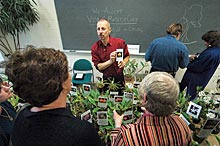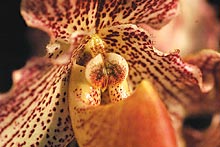From an overflowing parking lot, a horde of people swarmed toward the North Carolina Arboretum Education Center on March 29 for the first day of the Western North Carolina Orchid Society Show. Like ants on the trail of a picnic, everyone hurried as if the goodies inside might not last. In the other direction scurried proud owners bearing their newest treasures—cardboard boxes overflowing with the latest, most outrageous orchids.
Inside, the array of orchids had a sedative effect on the crowd. Suddenly one had to examine each plant in minute detail, spending hours determining which of the hundreds available was indeed the favorite. The swarm became a hum of contented admirers “oohing” and “aahing” among themselves as only the hopelessly addicted can do.

And rightly so. At this year’s show, the Orchid Society won 12 awards. Not national awards, mind you, but international ones, as in best in the world. Using a 100-year-old point system, nine certified judges sat down at a computer to compare each final contestant with previous award-winning orchids worldwide.
Twelve awards in one show is a highly unusual feat. Why would a small show rack up so many? According to Ralph Coffey, the society’s president, there are many reasons. WNC boasts a greater diversity of native plants than anywhere else on earth except for rain forests, so people who like to garden tend to move here. Gardeners tend to make good orchid growers. Furthermore, orchids are easily grown in Florida, and quite a few expert growers have moved here from there, sharing their talents with the group.
And though he didn’t say it, Coffey himself is another reason the Orchid Society is thriving. Although his day job is running the White Gate Inn on East Chestnut Street in Asheville, Coffey is also a serious gardener with a greenhouse full of orchids. He grows bizarre, unusual species like Maxillaria tenuifolia, whose flowers emit the fragrance of coconut suntan oil. Orchids like this can’t be had without a network, and Ralph’s includes H.B. Norton.
If the name is unfamiliar, consider this: A couple of years back, some poachers were caught in Peru with desperately rare orchids. The Peruvian government consulted the short list of experts in the world who might offer hope for saving and propagating the confiscated plants, and H.B. Norton was one of them. This is a man who’ll pay $800 for a flat of dead brown leaves in hopes of regenerating something from the roots. It was Norton who offered Phragmipedium blooms in yellow, red and orange when most nurseries were trading in just brown and green.
To the Asheville show, Norton brought an orchid that bloomed here for the first time in the world, and thus was named Phragmipedium kovachii ‘Asheville’. Speakers with this level of expertise have invaluable information to share, and H.B. Norton is a modern-day Darwin. He excels at the details, keeps good records, and shares his recipes for success. He attends only two orchid shows a year, and this is one of them.
Orchids have more species than any other plant in the world. They grow everywhere from the Arctic tundra to the equator. In WNC alone, we have 52 species of native orchids, including the well-known pink, showy and yellow lady’s slippers. Each species is unique, so growers must learn what makes their particular one thrive.

Ten vendors bought space at this year’s show. Their tables were artfully arranged, and tiers of shelves were stacked high along every wall. Scores of orchids dangled and danced from floor to ceiling in every color of the rainbow. For starters, imagine our native lady’s slipper glowing pale peach and twice its ordinary size, with modified petals dangling down to the ground like two strings so that ants could crawl up.
The variety of orchids is staggering, as is the realization that all this beauty is designed to entice insects. A specific flower shape ensures that a particular pollinator picks up or drops off its pollen load properly, happily transferring DNA while sipping nectar.
For this reason, Darwin studied orchids. In the 1860s, the Star of Bethlehem orchid was discovered in Madagascar. Darwin saw it and claimed that a pollinator must exist with the ability to reach the nectar at the bottom of its long, narrow nectar tube. (At the time, it was believed that orchids were self-pollinated). Everyone laughed at him, ridiculing the idea that such an insect might exist. Twenty-one years after Darwin’s death, the mysterious pollinator was found: a hawk moth with a 12-inch proboscis. Darwin got the last laugh. He was light-years ahead when he wrote:
“Considering how precious the pollen of the Orchids evidently is, and what care has been bestowed on its organisation and the accessory of parts;—considering that the anther always stands close behind or above the stigma, self-fertilisation would have been an incomparably safer process than the transportal of the pollen from flower to flower. It is an astonishing fact that self-fertilisation should not have been an habitual occurrence. It apparently demonstrates to us that there must be something injurious in the process. Nature thus tells us, in the most emphatic manner, that she abhors perpetual self-fertilisation.”
The orchid, in fact, produced some of Darwin’s strongest evidence for evolution. Today, most orchid evolution takes place through cross-pollination via human hands. We also produce vast numbers of orchids by means of tissue culture, in which each orchid is a clone of its parent. The hawk moth may not survive in the wild for long, but the seductive blooms of the Star of Bethlehem and all its gorgeous relatives have ensnared a new pollinator.
One can’t help but wonder what Darwin would have made of all this if he could have watched us swarm in and out of the arboretum under the orchid’s sensual spell.
If you can’t wait till next year’s show, check the WNC Orchid Society’s Web site (www.wncos.org), or visit the Fuqua Orchid Center at the Atlanta Botanical Garden (www.atlantabotanicalgarden.org), which features cloud orchids that grow at elevations above 7,500 feet.
[Amy Fahmy is the horticulturist for Biltmore Farms.]



Before you comment
The comments section is here to provide a platform for civil dialogue on the issues we face together as a local community. Xpress is committed to offering this platform for all voices, but when the tone of the discussion gets nasty or strays off topic, we believe many people choose not to participate. Xpress editors are determined to moderate comments to ensure a constructive interchange is maintained. All comments judged not to be in keeping with the spirit of civil discourse will be removed and repeat violators will be banned. See here for our terms of service. Thank you for being part of this effort to promote respectful discussion.